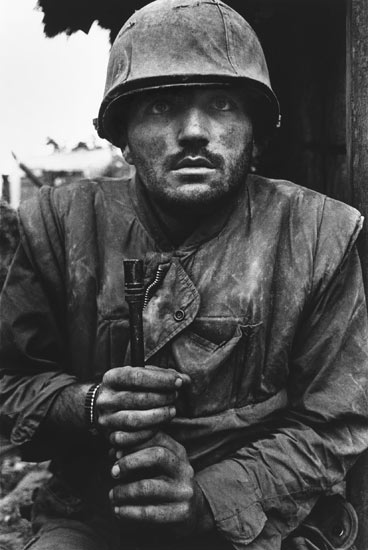
Don McCullin - 'Shaped By War'
(Imperial War Museum, London, 19th Jan 2012)
There is something about photography, some innate sense of actuality - a moment plucked from reality and frozen within the frame - that lends it an almost helpless objectivity. You may be forgiven for breezing through a gallery of artwork waiting for that revelatory discovery of brilliance to launch itself at you from the periphery, or for feeling disenchantment on viewing a painting held in lofty esteem by the masses. There is a certain element of self-investment in viewing art; what you get from it is often tangential to the mentality you approach it with. Because what we are viewing is purely the artist's representation of his private reality, rendered through skill and technique to canvas, it does require a certain amount of subjective engagement with the artist's vision.
Art leaves itself open to ambivalence and misconception. Photography, on the other hand, by its very nature cast in concrete verity (and therefore also because of the lesser demands on the viewer's own imagination in tandem with that of the artist's), demands a reaction.
Indeed it would be impossible to be ambivalent about the work of Don McCullin, photojournalist for 'The Observer' and 'The Sunday Times', and purveyor of some of the most visceral and harrowing war images of the 20th century. Sent to cover some of the most dangerous places in the world - from the Cypriot civil war, to Vietnam, the Londonderry riots, to Cambodia - the exhibition is perfectly encapsulated by its title. It is as much a study of the man behind the lens, a life well and truly 'shaped by war'.

The horror and the intensity of the situations are scorched across every one of McCullin's well-crafted images. At times you can actually sense the panic and the chaos, the bullets flying overhead, the mud and the stench of fear. You stare at the photo of the shell-shocked soldier in Vietnam and you can almost hear the bombs punctuating the air around him like morse code. You stare at the famous image of the distraught Turkish wife (which won him the World Press Award in 1964) and can almost taste the bitter despair crystallised in a moment of raw human emotion.

Of course no photograph can capture the sheer terror of the situations as witnessed first-hand. Watching the accompanying documentary film, McCullin admits to an 'uneasy enjoyment' of his time spent in such hostile environments. In a way this is perfectly understandable. The level of tension and adrenalised energy that must be exerted and relied upon whilst immersed in a war zone, where the next bullet or mortar blast could be the one that claims you, must be undeniably potent and surely have intoxicating agencies. In the same way as the motor-sport driver, stunt pilot or daredevil straddles the boundary of mortality, the thrill of emerging on the other side alive must be as compulsive as any drug.
As with any member of the armed forces, constantly exposed to such extreme situations from which they may not survive, the succumbing to combat neurosis and the readjustment process once back home must be disorientating and harsh. Indeed, McCullin once said - 'when I was at home away from war, I was unhappy'. This must have invoked his obsessive urge to dive back into the ferocity of the front line, to re-engage with danger time and again; and perhaps elucidates his anger (alongside obviously a sense of professional pride) when refused a press pass to cover the Falklands conflict and his regret at having visited but 'not seen any action' in the Gulf war.
This is not to suggest any perverse revelling in such situations, but instead demonstrates a burning desire to be at the epicentre of the event, thereby capturing it as accurately, honestly and unflinchingly as possible. It is only natural that one's psychology be permanently altered by the exposure to murder and destruction on such a grand scale. By comparison, normal everyday life must forever after assume a kind of removed and faded tonality, akin to underdeveloped photo film in a dark-room.
One of the pervading emotions McCullin expresses throughout his story is of a sense of guilt. A guilt at being in such close proximity to men killed for their country, and being forced by professional duty to stay emotionally detached, remain partisan and capture the moment as truthfully as able. As he says, 'what a way to make a living!' His yearning to 'do his bit' is emphasised in moments such as when, embroiled in the Battle of Hue, he carried a wounded solider out of the firing line. He also described feeling like 'a Judas to both sides' when covering the Londonderry riots in Northern Ireland.
Ultimately though, this is misguided guilt, albeit also perfectly understandable. The overriding lesson to be gleaned from the exhibition is just how necessary and vital photojournalism is in terms of throwing bright light on the darkest of human endeavours. With the rise of 21st century 'citizen journalism', where anybody with a camera phone can assume a McCullin-style role, the importance of responsible and unbiased representation cannot be understated.
However they enter the public domain, we must feel an obligation to view these images, regardless of how distressing, in order that we might be afforded a more salient understanding of the events as they happened, but never allow them to lull us into complacent acceptance, thereby neglecting to ponder the reasons why the events had to happen at all.
No comments:
Post a Comment